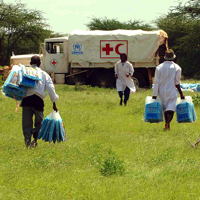Editor's note: This is the first of a five-part series examining security and development aid and capacity-building in East Africa. Part I provides an overview of the challenges facing East Africa. Part II will examine the overlap between public health and security challenges. Part III will examine the overlap between small arms trafficking and WMD nonproliferation. Part IV will examine the overlap between counterterrorism and efforts to contain criminal violence. Part V will provide success stories for the security-development model and discuss next steps.
According to the World Bank, more than half of the people in sub-Saharan Africa live in poverty, defined as living on less than the equivalent of $1.25 per day. Water-borne diseases such as cholera also affect more than half of all Africans, while an African child dies of malaria every 30 seconds, amounting to more than 1 million child deaths each year.
In parts of East Africa, the poverty rate exceeds 80 percent. Disease, food insecurity and a lack of affordable health care and education are just a few of the profound challenges also facing the region. New and festering conflicts contribute to the shackles of poverty, as widespread violence across East African countries significantly hampers prospects for economic development. While many parts of the world have experienced a decrease in armed conflict in recent years, Africa continues to be a hotbed of violence, fueled by the millions of small arms and light weapons illicitly circulating throughout the continent.

